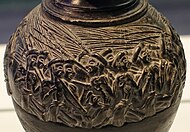Harvester Vase
| Harvester Vase | |
|---|---|
 | |
| Material | Black steatite |
| Created | c. 1550–1500 BC |
| Period/culture | Neopalatial |
| Discovered | Hagia Triada |
| Present location | Heraklion Archaeological Museum |
| Identification | AE 184 |
| Culture | Minoan |
The Harvester Vase is a Late Bronze Age stone vase or rhyton found at Hagia Triada, an ancient "palace" of the Minoan civilization in Crete.[1] It is now in the Heraklion Archaeological Museum, and is an important example of Minoan Neopalatial art, dating to about 1550 to 1500 BC.[2][3]
The vase was made in three parts of which the lowest is missing, and has been replaced with undecorated plaster.[4] A band of relief running around the widest part of the vase depicts men marching in a harvest celebration,[1] probably with a religious element.[5]
The scene has been praised for its "impression of vital, rhythmic movement", though exactly what it shows has been much argued about. It is effectively unique in Minoan art, where detailed depictions of ordinary people are otherwise virtually non-existent.[6]
All the three most important Minoan carved stone vases with figurative scenes of humans were found at Hagia Triada Archeological site in Greece. The "Chieftain Cup" is probably by the same artist, perhaps working at Knossos. The third is the "Boxer Vase".[7]
Description
The vase is made in the form of an ostrich egg; this was a rare and exotic object in the Bronze Age Mediterranean, used to make rhyta. It would have had a second hole at the bottom for ritual drinking or libation, that was stopped with a finger until a flow was required.[1][8] It was probably originally coated with gold leaf,[3] in whole or part.[9]
Around the widest part runs a relief of a procession, perhaps a dance, of some 26 men. This is cut off at the level of their legs, but presumably was continued on the missing lowest section. Most of the men are young and dressed in the same way, with short kilts and "flat roll-brimmed caps". Exceptions are an older-looking man with long hair and a coat decorated with a pattern of scales or scallops. He carries a long staff curved at the bottom, and seems to be leading the group. There is also a man with a sistrum, a rattle-like musical instrument, who has his mouth wide open, and may be singing. Behind him come four men wearing cloaks, who also have their mouths wide open.[10][1]
Among the men, near the end of the procession, one figure has turned round, perhaps to help a figure whose head is much lower down. He has perhaps fallen down drunk.[11]
Interpretation
The main body of the "rank and file" carry "curious three-pronged poles" over their shoulders and have "bag-like objects" around their knees.[12] This equipment has been much discussed, and is often taken as representing kit for either sowing or harvesting and threshing cereal crops. Equipment for olive harvesting has also been suggested. A military purpose was the first thought of the discoverers,[13] but has been less popular with later writers.[14][1] Dieter Rumpel considers the practicability of the three-pronged implements for the various agricultural tasks proposed for them, and concludes they would not work. He returns to a military purpose, or rather naval, as stabbing weapons for use in close contact between boats.[15]
-
The older "leader"
-
The sistrum player (right) and cloaked singers
-
Wide view from a cast in the museum, the singers at right
-
The man turned back, and the fallen man.
Notes
- ^ a b c d e German, Senta (16 Aug 2018). "Harvester Vase". Smarthistory. Retrieved 2023-09-21.
- ^ Tausch, Olaf (18 Aug 2013). "Harvester Vase". World History Encyclopedia. Retrieved 2023-09-21.
- ^ a b Forsdyke, John (1954). "The 'Harvester' Vase of Hagia Triada". Journal of the Warburg and Courtauld Institutes. 17 (1/2): 1–9. doi:10.2307/750129. ISSN 0075-4390. JSTOR 750129. S2CID 195041929.
- ^ "The permanent exhibition of the Heraklion Archaeological Museum: The Harvester vase". Odysseus. Ministry of Culture and Sports. Retrieved 2023-09-21.; for a different reconstruction of the bottom, see this replica in Harvard
- ^ Hood, 65
- ^ Hood, 145
- ^ Hood, 143
- ^ Forsdyke, 1
- ^ Hood, 147
- ^ Hood, 145–146, 145 quoted. Exact counts vary between the sources.
- ^ Hood, 146
- ^ Hood, 146
- ^ See R.C. Bosanquet, N.M. Tod: Archaeology in Greece 1901–1902, 1902, quoted by Rumpel here
- ^ Forsdyke, 1; Hood, 145–146, 146 quoted.
- ^ Rumpel
References
- Hood, Sinclair, The Arts in Prehistoric Greece, 1978, Penguin (Penguin/Yale History of Art), ISBN 0140561420
- Rumpel, Dieter, "The "Harvester" Vase Revised", Anistoriton Journal, Insitu Vol 10, No. 3, 2007




